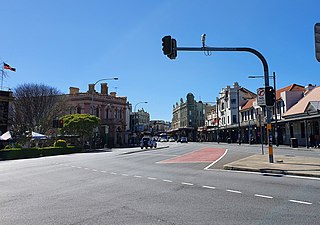
Newtown, a suburb of Sydney's inner west, is located approximately four kilometres south-west of the Sydney central business district, straddling the local government areas of the City of Sydney and Inner West Council in the state of New South Wales, Australia.

Rookwood Cemetery is a heritage-listed cemetery in Rookwood, Sydney, Australia. It is the largest necropolis in the Southern Hemisphere and is the world's largest remaining operating cemetery from the Victorian era. It is close to Lidcombe railway station about 17 kilometres (11 mi) west of the Sydney central business district. It was added to the New South Wales State Heritage Register on 2 April 1999.

West Norwood Cemetery is a 40-acre (16 ha) rural cemetery in West Norwood in London, England. It was also known as the South Metropolitan Cemetery. One of the first private landscaped cemeteries in London, it is one of the "Magnificent Seven" cemeteries of London, and is a site of major historical, architectural and ecological interest.

Central is a heritage-listed railway station located in the centre of Sydney, New South Wales, Australia. The station is Australia's largest and second busiest railway station in Australia and serves as a major transport interchange for NSW TrainLink inter-city rail services, Sydney Trains commuter rail services, Sydney light rail services, bus services, and private coach transport services. The station is also known as Sydney Terminal. The property was added to the New South Wales State Heritage Register on 2 April 1999. It recorded 85.4 million passenger movements in 2018 and serves over 250,000 people daily.

Town Hall railway station is a heritage-listed underground commuter rail station located in the centre of the Sydney central business district in New South Wales, Australia. The station opened on 28 February 1932. It is named after the Sydney Town Hall, located directly above the station.
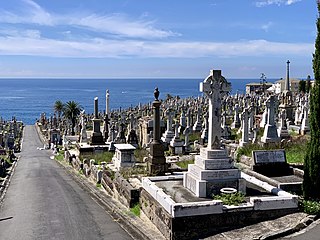
The Waverley Cemetery is a heritage-listed cemetery on top of the cliffs at Bronte in the eastern suburbs of Sydney, New South Wales, Australia. Opened in 1877 and built by R. Watkins and P. Beddie, the cemetery is noted for its largely intact Victorian and Edwardian monuments. It is regularly cited as being one of the most beautiful cemeteries in the world. The cemetery contains the graves of many significant Australians including the poet Henry Lawson. Also known as General Cemetery Waverley, it was added to the New South Wales State Heritage Register on 28 October 2016.

Flagstaff Gardens is the oldest park in Melbourne, Victoria, Australia, first established in 1862. Today it is one of the most visited and widely used parks in the city by residents, nearby office workers and tourists. The gardens are notable for their archaeological, horticultural, historical and social significance to the history of Melbourne.

Alberton is a metropolitan suburb in the west of Adelaide, South Australia, about 20 minutes drive from the city. Part of the City of Port Adelaide Enfield, it is bordered by the suburbs of Rosewater, Queenstown, Cheltenham and Port Adelaide.

African Burial Ground National Monument is a monument at Duane Street and African Burial Ground Way in the Civic Center section of Lower Manhattan, New York City. Its main building is the Ted Weiss Federal Building at 290 Broadway. The site contains the remains of more than 419 Africans buried during the late 17th and 18th centuries in a portion of what was the largest colonial-era cemetery for people of African descent, some free, most enslaved. Historians estimate there may have been as many as 10,000–20,000 burials in what was called the Negroes Burial Ground in the 18th century. The five to six acre site's excavation and study was called "the most important historic urban archaeological project in the United States." The Burial Ground site is New York's earliest known African-American cemetery; studies show an estimated 15,000 African American people were buried here.

St Marys is a suburb in western Sydney, in the state of New South Wales, Australia. It is 45 kilometres west of the Sydney central business district, in the local government area of the City of Penrith.
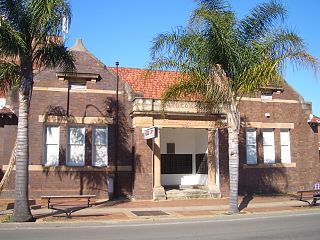
Lidcombe is a suburb in western Sydney, in the state of New South Wales, Australia. Lidcombe is located 15 km (9.32 mi) west of the Sydney central business district, in the local government area of Cumberland Council, with a small industrial part in the north in the City of Parramatta. Post code: 2141, sharing it with Berala.
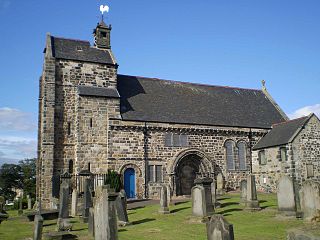
Kirkliston is a village and parish to the west of Edinburgh, Scotland, historically within the county of West Lothian but now within the City of Edinburgh council area limits. It lies on high ground immediately north of a northward loop of the Almond, on the old road between Edinburgh and Linlithgow, having a crossroads with the road from Newbridge to Queensferry and beyond to Fife. The B800 is variously named Path Brae, High Street, Station Road, and Queensferry Road as it passes through the town. The B9080 is named Main Street and Stirling Road as it passes through.
Oaks Estate is a suburb in the district of Jerrabomberra, Canberra, Australian Capital Territory in Australia. It is situated on the northern side of the Australian Capital Territory and New South Wales border abutting the town of Queanbeyan in south-eastern New South Wales, Australia. The estate covers an area of approximately 40 hectares and is bound by the Molonglo River to the north, the Queanbeyan River to the east, 'The Oaks' to the west, and the Queanbeyan-Cooma railway to the south. Oaks Estate is located 12 kilometres from the centre of Canberra. The village is also noteworthy as the nucleus of Queanbeyan's industrial development during the second half of the 19th century. Oaks Estate takes its name from 'The Oaks', which was part of Duntroon, Robert Campbell's farming estate. This makes Oaks Estate one of only a few place names in the ACT with significant connections to early colonial times.

The Sydney Town Hall is a late 19th-century heritage-listed town hall building in the city of Sydney, the capital city of New South Wales, Australia, housing the chambers of the Lord Mayor of Sydney, council offices, and venues for meetings and functions. It is located at 483 George Street, in the Sydney central business district opposite the Queen Victoria Building and alongside St Andrew's Cathedral. Sited above the Town Hall station and between the city shopping and entertainment precincts, the steps of the Town Hall are a popular meeting place.

Elizabeth Street is a major street in the central business district of Sydney in New South Wales, Australia. The street continues south of the central business district (CBD), through the inner city suburbs of Surry Hills, Redfern and Waterloo, before terminating in Zetland. Elizabeth Street lies within the City of Sydney local government area.
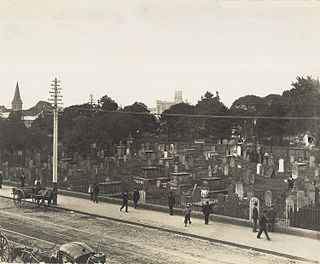
The Devonshire Street Cemetery was located between Eddy Avenue and Elizabeth Street, and between Chalmers and Devonshire streets, at Brickfield Hill, in Sydney, Australia. It was consecrated in 1820. The Jewish section was used from 1832. By 1860, the cemetery was full, and it was closed in 1867.
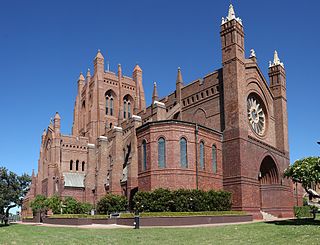
The Cathedral Church of Christ the King, also called Christ Church Cathedral, is an Anglican cathedral in Newcastle, New South Wales. It is the cathedral church of the Diocese of Newcastle in the Anglican Church of Australia. The building, designed by John Horbury Hunt in the Gothic Revival style, is located on a hill at the city's eastern end in the suburb called The Hill. It was added to the New South Wales State Heritage Register on 28 June 2011.

The First Brisbane Burial Ground is a heritage-listed archaeological site at Skew Street, Brisbane City, City of Brisbane, Queensland, Australia. It is also known as Skew Street Cemetery. It was established in 1825 as part of the Moreton Bay penal settlement. It was added to the Queensland Heritage Register on 16 July 2010.

St Peter's Anglican Church is a heritage-listed Anglican church and associated Sunday school, rectory, and cemetery at 384 Windsor Street, Richmond, City of Hawkesbury, New South Wales, Australia. It was designed by Francis Clarke and Edmund Blacket and built from 1836 to 1841 by James Atkinson (church). It is also known as St Peter's Anglican Church Group, St Peter's Church Group, Church, Rectory, Church Yard, Cemetery and Stables. It was added to the New South Wales State Heritage Register on 16 August 2019; and on the City of Hawkesbury local government heritage register, and listed on the New South Wales Heritage Database on 12 September 2012.


















